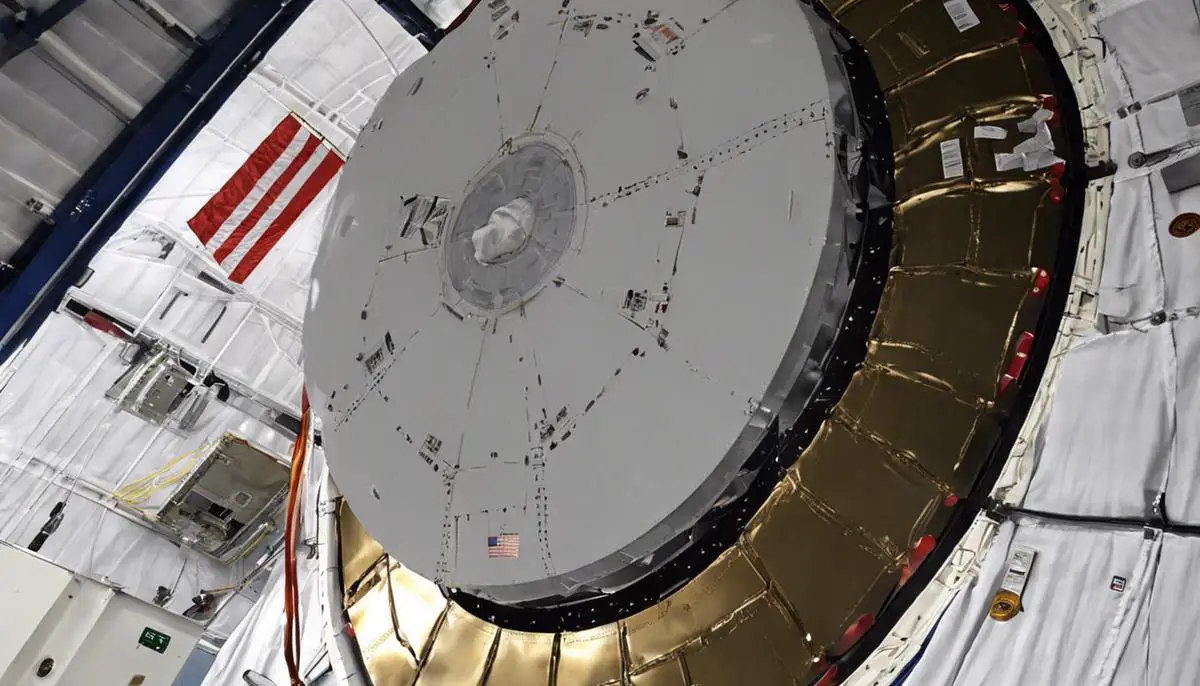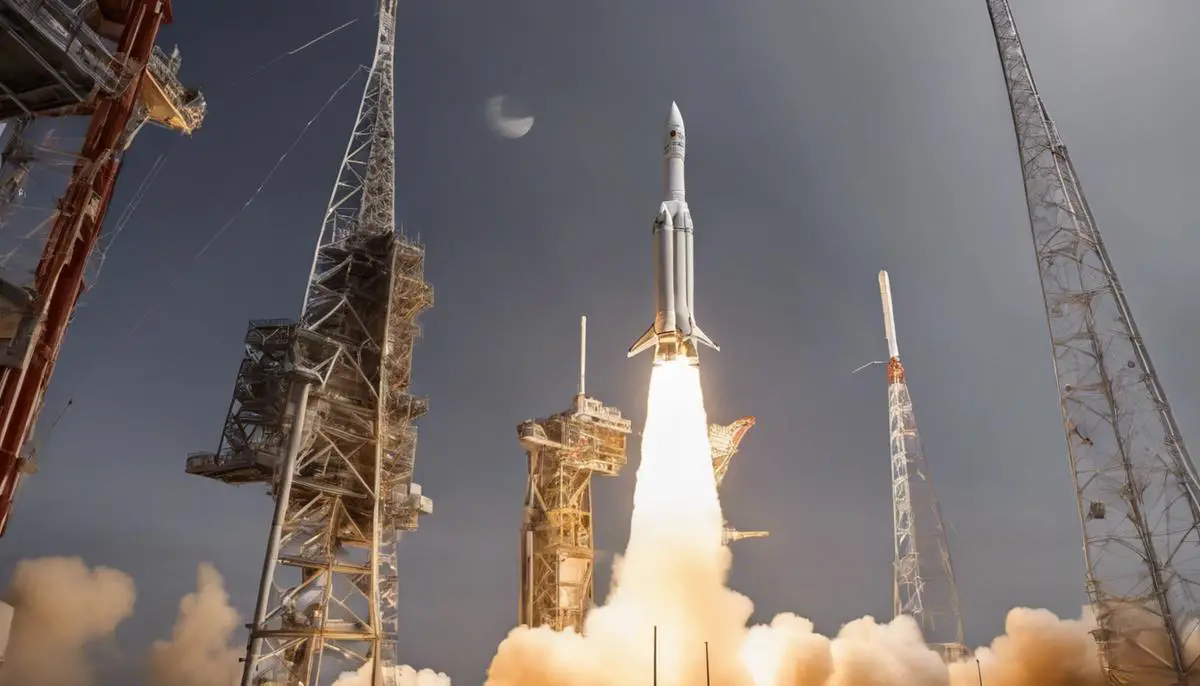Embarking on a journey through the cosmos, the Artemis missions represent a pivotal chapter in human space travel. With a focus on the technological marvels and the rigorous preparation that astronauts undergo, this narrative sheds light on the intricate dance between human ingenuity and the unforgiving nature of space. From the life-sustaining systems of the Orion capsule to the groundbreaking designs of spacesuits and spacecraft, each element plays a critical role in ensuring the safety and success of these lunar expeditions.
Contents
Orion Capsule Systems
The Orion spacecraft is equipped to keep astronauts alive and well during their journey. This capsule, ready to carry humans farther into space than before, comes equipped with the Environmental Control and Life Support Systems (ECLSS). These systems are astronauts' lifelines, carrying out essential tasks like:
- Managing the air they breathe
- Keeping the temperature just right inside the capsule
- Making sure carbon dioxide doesn't reach dangerous levels
The ECLSS on Orion ensures fresh oxygen is always available while removing harmful carbon dioxide from the capsule's atmosphere. It maintains the right mix for astronauts to comfortably breathe.
Temperature control is another critical job for the ECLSS. The system ensures that the interior of the capsule remains at a comfortable, constant temperature no matter what's happening outside.
The ECLSS also includes robust technology to capture and remove CO2. It ensures that the air inside Orion stays fresh, preventing buildup that could spell trouble for crew members.
These systems combined form a complex network of support that simulates Earth-like conditions, providing a sustainable habitat for astronauts deep in space. The ECLSS on Orion does its work quietly but efficiently, making sure the focus remains on exploration, not survival.
Designing the ECLSS was a challenge for engineers – planning how to replicate Earth's living conditions in a spacecraft zipping through the vacuum of space. It's a testament to human ingenuity and our drive to explore the unknown, ensuring astronauts can venture into space, not just to survive but to thrive.
Orion's ECLSS is one piece of the puzzle in ensuring the success of Artemis missions. By solving the mysteries of living in space, we're paving the way for longer expeditions, perhaps one day reaching Mars. This journey starts with ensuring that, miles above Earth, astronauts can breathe easy, stay comfortable, and keep exploring.
Heat Shield Integrity
Heat Shield Integrity
Venturing into the cosmos requires a spacecraft that can withstand the intense heat of re-entry into Earth's atmosphere. This is where the heat shield, Orion's unsung hero, plays a critical role. The integrity of this component is paramount; it's a safeguard that ensures the capsule and its crew can safely return home. The unexpected loss of char layer pieces during Artemis I's test flight highlighted the need for meticulous attention to the shield's resilience.
The heat shield serves as Orion's frontline defense against the fiery gauntlet of re-entry. As the spacecraft hurtles Earthward, it encounters extreme temperatures. The char layer of the heat shield is designed to absorb and dissipate this intense heat, effectively burning away in a controlled manner to prevent the rest of the spacecraft from overheating.
However, the Artemis I mission revealed an issue when pieces of this crucial layer separated from the spacecraft during re-entry. This was an unexpected event that raises concerns—because when it comes to re-entry, there is no room for error. The implications are significant, not just for the safety of astronauts on future Artemis missions but also for the overall success of these lunar endeavors.
Teams of engineers are now diligently analyzing data, conducting tests, and refining models to ensure this anomaly is understood and corrected. The integrity of the heat shield is a non-negotiable aspect of space exploration, and NASA's commitment to resolving this issue underscores the emphasis on crew safety. It's a reminder that in space, learning never stops and perfection is always the goal.
Understanding and rectifying the loss of the heat shield's char layer is about reinforcing our resolve to protect those who dare to push the boundaries of human exploration. Through diligent inquiry and innovation, enhancements to the heat shield will emerge, illuminating our path forward, not only back to the Moon but eventually to Mars.
As we stand on the brink of launching humans further into space than ever before, the events surrounding Artemis I serve as a powerful reminder: every component of the Orion spacecraft plays an essential role in the success of space exploration. The heat shield's integrity is paramount, safeguarding the lives of those aboard Orion and ensuring that after crossing the cosmic sea, they can return safely.

Gateway Station Support
Gateway Station Support
As humanity readies itself for the next giant leap in space exploration, the Lunar Gateway emerges as a cornerstone in NASA's Artemis program, slated to redefine our understanding of what it means to live and work beyond Earth's bounds. Perched in a unique orbit around the Moon, the Gateway isn't merely an outpost; it's a multifunctional launchpad for ambitions, scientific quests, and future Mars missions.
The Gateway's life support capabilities echo the marvels in the Orion capsule but on a larger scale. It will provide a serene habitat for astronauts, with harmonious air circulation, thermal regulation, and the removal of carbon dioxide. Imagine astronauts floating through corridors, sustained by an environment that feels like home.
Beyond habitability, the Gateway champions the cause of science. Equipped with advanced laboratories, it enables experiments that defy gravity. Here, questions on cosmology, human physiology, and the unseen forces that sculpt our universe can be explored. Each module serves as both sanctuary and crucible for knowledge, germinated for our species' enduring legacy among the stars.
The Gateway also stands as a testament to strategic ingenuity – a springboard to the Moon's untouched regions. Astronauts will assemble here, preparing for descents onto the lunar surface. This is where plans are drawn, where boots meet moon dust, and where humanity's lunar excursions become reality.
Implementing this cosmic outpost carries complexities that stretch the limits of present ingenuity. The challenge lies not merely in creating a livable environment but ensuring it thrives autonomously. Unlike the ISS's continuous human presence, the Gateway anticipates intervals of vacancy, waiting to greet its transient guests. This demand for self-sufficiency introduces a blend of robotics, artificial intelligence, and adaptive systems—a testament to human innovation when faced with the unknown.
The Gateway also reflects international cooperation, as Canada's Canadarm3 suggests – showing the lunar endeavor as a mosaic of global aspirations. As this celestial venture unfolds, the Lunar Gateway supports more than astronauts; it underpins hope, audacity, and the irrevocable zest to aspire further.
Envision a future where the Gateway glints, a silhouette against Earth-rise on the lunar frontier. Here lies humanity's interim homestead; a bridge not only between worlds but between dreams ready to be cast across the cosmic oceans.
SpaceX and Axiom Tech
SpaceX and Axiom Tech: Pioneering Moonwalks Reimagined
As we inch closer to the Moon's allure under the Artemis banner, two names stand out: SpaceX and Axiom Space. Their forthcoming contributions? The Human Landing System (HLS) and spacesuits of tomorrow, respectively. These advancements are giant leaps in ensuring that astronauts not only arrive safely on the lunar surface but do so with the prowess of interstellar trailblazers.
SpaceX brings forth the HLS—a marvel of engineering poised to ferry astronauts from lunar orbit to the Moon's surface. This vehicle intertwines strength with the finesse required to touch down on lunar terrain, all while protecting human lives against the stark vacuum and unforgiving environment. The HLS represents human ingenuity, ready to brave the challenges countless times over, offering a bridge between the Gateway's promise and the historical whispers across the lunar expanse.
Axiom Space, armed with layers of protection against lunar adversities, designs spacesuits for the new age of lunar exploration. Axiom's next-generation spacesuits promise agility and a range of protections against everything the Moon has to offer, from abrasive regolith to extreme temperatures. These spacesuits serve as personal habitats, enabling leaps and bounds or painstaking geological surveys alike. They preserve life, wield advanced materials for armor, and cater a touch of elegance to dances on the ancient, cratered stages.
The lunar environment poses challenges with its lack of atmosphere, stark temperature fluctuations, and regolith as fine as powder yet as abrasive as sandpaper. Here, SpaceX's HLS must demonstrate precision in landing and takeoff, navigating treacherous terrain while cradling its precious cargo of life and dreams. Reliability is key; these vessels are lifelines, the only rides home under Artemis's watchful gaze.
Similarly, Axiom's spacesuits face their trials on this alien stage, shielding astronauts from harsh radiation, extreme cold within shadows, and scorching sunlight. These suits must afford mobility—enabling scientists to deploy experiments, collect samples, and carve moments of human zealousness across the lunar frontier.
Together, SpaceX's HLS and Axiom's next-generation spacesuits encapsulate a symphony of technology and vision intertwined with Artemis's aspirations. They address not simply the how of lunar touchdowns but the boldness of endeavoring grandly—assuring that when humanity once more reaches the Moon's surface, it does so with assurance, dexterity, and a yearning eye cast towards new horizons.
As we pivot on the precipice of returning to the Moon, let us herald these technological marvels. Within the delicate creases of their designs lies our nascent capability to not only explore but to persist and proliferate amidst the cosmos.

Artemis Training and Preparedness
The Artemis Training and Preparedness program is designed to prepare astronauts for the challenges of spaceflight and lunar exploration. Through realistic simulations and rigorous drills, astronauts learn to handle life support system failures and emergencies in the Orion spacecraft and on the lunar surface.
In the Orion simulators, astronauts face virtual scenarios where oxygen levels drop or pressure fluctuates. They become familiar with every aspect of the spacecraft, ensuring they can take decisive action if the Environmental Control and Life Support System (ECLSS) malfunctions.
On Earth, astronauts train in environments that simulate the lunar surface, complete with moondust and challenging terrain. Wearing sensor-laden Axiom suits, they practice navigating the landscape and troubleshooting issues with rovers or habitat modules.
Mock-ups and VR-enhanced drills ensure that when astronauts set foot on the Moon, they are prepared for both expected and unexpected challenges. They learn to work as a team, fostering resilience and determination in the face of space's solitude and potential hazards.

The Artemis missions demonstrate human resilience and adaptability. The thorough preparation of astronauts, combined with advanced spacecraft and equipment engineering, emphasizes the importance of safety and excellence in space exploration.1 As we embark on these lunar adventures, our dedication will ensure that our presence on the Moon is not just a brief visit, but a significant step towards a sustainable future in space.
